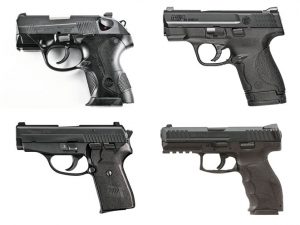The .40 Cal S&W is a rimless pistol ammunition created for the Federal Bureau of Investigation by firearms manufacturers Smith & Wesson and Winchester. The .40 S&W (10x22mm) was developed from scratch after the failed FBI shootout in Miami in 1986. The confrontation left two FBI agents dead, with five wounded. The agents fatally wounded the two criminals.
The FBI commissioned Smith & Wesson and Winchester to create an ammo that could be retrofitted into their existing 9mm semi-automatic handguns. S&W and Winchester based the new ammunition on 9mm and .45 ACP cartridges. The new cartridge would function as a medium velocity round mimicking the accuracy of a 9mm, but using the parameters of a 10mm load.
The team satisfied FBI requirements. The new medium ground ammo could be used by agents in a standard issue semi-automatic pistol. The FBI believed that the new standard issue would prevent another disaster like the one they faced in Miami.
Development of the .40 S&W
The FBI determined that the standard issue .38 Special revolvers had lost their effectiveness. They switched to 10mm cartridge and the S&W 1076 Auto shortly before the Miami shootout. The FBI determined the agents’ deaths were caused by lack of ammunition, heavy recoil, and the difficulty of reloading quickly in the field. It was imperative to find a new, more effective ammo to prevent future debacles.
S&W and Winchester completed the development of .40 Cal bullets in 1990, along with the Smith & Wesson Model 4006 pistol, six months after receiving the request from the FBI. The result of the collaboration was an ammunition with the stopping power of a .45 ACP round, with the ease of use of a 9mm.
The FBI adopted the .40 Cal S&W. Law enforcement agencies around the country quickly followed suit. The United States Coast Guard and police forces in Canada and Australia also adopted the .40 S&W and still use it today.
The FBI currently endorses the Sig Sauer P226 and P228, chambered in 9mm and .40 cal.
Specs
The .40 Cal S&W uses a 0.40-inch diameter lead bullet ranging in weight from 105 to 200 grains.
The middle ground ammunition has adequate stopping power for self-defense and concealed carry. The recoil is manageable for novice and shooters with a smaller frame.
The .40 S&W casing measures .85-inch-long, .424-inch at the base. It has an average pressure of 35,000 psi. The energy of the ammo exceeds the standard-pressure of the .45 ACP.
Based on ideal terminal ballistic performance testing in the 1980s and 1990s, the .40 S&W was touted as “the ideal cartridge for personal defense and law enforcement”. The .40 Cal S&W is almost identical to the ballistics of the .38-40 Winchester introduced in 1874, with the same bullet diameter and weight, as well as having similar muzzle velocities.
Alternate Names
- .40 Caliber
- .40 Cal
- .40 Auto
- 10×22mm
- 10mm Kurz
The .40 Cal S&W for Self-Defense
The .40 S&W is attractive to civilians due to its ease of use and light recoil. People seeking ammo for self-defense situations demand accuracy and stopping power. The .40 cal meets those requirements. Consumers have a variety of options for bullet weight and design.
Civilians appreciate the same features coveted by law enforcement, including magazine capacity, muzzle energy, and light recoil. The round is accurate and easy to manage, making it ideal for concealed carry and self-defense. While it isn’t the most popular round on the market, most new firearms offer compact and subcompact models chambered for the .40 Cal.

